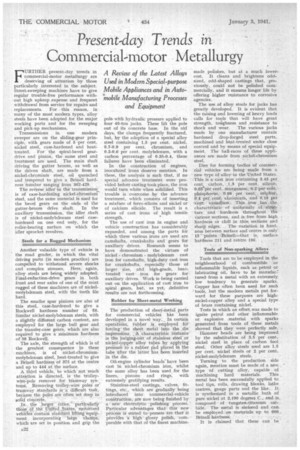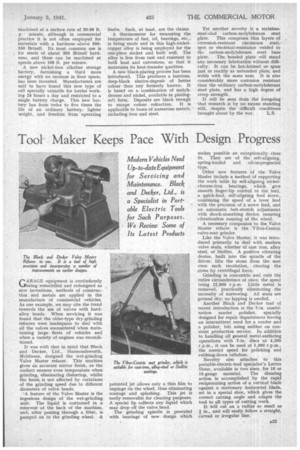Present-day. Trends in Commercial-motor Metallurgy
Page 24

Page 25

If you've noticed an error in this article please click here to report it so we can fix it.
A Review of the Latest Alloys Used in Modern Special-purpose Mobile Appliances and in Auto*mobile Manufacturing Processes
and Equipment
FURTHER present-day trends in commercial-motor metallurgy are deserving of attention by those particularly interested in the subject. Street-sweeping machines have to give regular trouble-free performance without high upkeep expense and frequent withdrawal from service for repairs and replacements. For this reason, in many of the most modern types, alloy steels have been adopted for the major working parts and for the sweeping and pick-up mechanisms.
Transmissions in one modern sweeper are on the sliding-gear principle, with gears made of 5 per cent. nickel steel, case-hardened and heat treated. For the spiral-bevel geardrive and pinion, the same steel and treatment are used. The main shaft driving the gutter broom, as well as the driven shaft, are made from a nickel-chromium steel, oil quenched and tempered to give a Brinell hardness number rangMg from 362-429. .
The reVerse idler -in the transmisSion. is of case-hardening nickel-chromium steel, and the same material is used for the bevel gears on the ends of the gutter-broom drive shaft. In the auxiliary transmission, the idler shaft is of nickel-molybdenum steel casehardened on one end only, for the roller-bearing surface on which the idler sprocket revolves.
Steels for a Rugged Mechanism Another valuable type of vehicle is the road grader, in which the vital driving parts (in modern practice) are compelled to withstand severe shocks and complex stresses. Here, again, alloy steels are being widely adopte± Final-reduction-drive gears in both front and rear axles of one of the most rugged of these machines are of nickelmolybdenum steel, with the teeth file bard.
The smaller spur pinions are also of this steel, case-hardened to give a Rockwell hardness number of .58. Similar nickel-molybdenum steels, with a slightly different carbon content, are employed for the large bull gear and the transfer-case gears, which are also required to give a minimum hardness of 58 Rockwell.
The axle, the strength of which is of the greatest • consequence in these machines, is of nickel-chromiummolybdenum Steel, ,heat-treated 'to give a Brinell hardness of 375 at the 'centre
and up to 444 at the surface. . A third vehicle, to which' not -much attention is directed, is the trolleywire:pole remover for tramway systems Removing trtiliey-wire' polesor tramway standards is difficult task, because the poleS are often -set, deep' in
solid concrete. •• •
In the larger -:Cities: particularly those of the sTii*eci ,States mOtdrind vehicles Contain standard,lifting'equip-.. ment incorporating large
which are set in position and grip the polewith hydraulic pressure applied to four 40-ton jacks. These lift the pole out of its concrete base. In the old days, the clamps frequently fractured, but, by the adoption of a special alloy steel containing 1.5 per cent. nickel, 0.7-0.9 per cent, chromium, and 0.2-0.6 per cent, molybdenum, with a carbon percentage of 0.35-0.4, these failures have been eliminated.
In the construction of engines, inoculated irons deserve mention. In these, the analysis is such that, if no special advance treatment were provided before casting took place, the iron would turn white when solidified. This trouble is overcome by the advance treatment, which consists of inserting a mixture of ferro-silicon and nickel or of calcium silicide. The result is a series of cast irons of high tensile strength.
The use of cast iron in engine and vehicle construction has considerably expanded, and among the parts for which these various irons are used are camshafts, crankshafts and gears for auxiliary drives. Research seems to have demonstrated the virtues of nickel chromium molybdenum cast iron for camshafts, high-duty cast iron for crankshafts, especially those of larger size, and high-grade, heattreated cast iron for gears for auxiliary drives. Work is being carried out on the application of cast iron to spiral gears, but, as yet; definitive results are not forthcoming.
Rubber for Sheet-metal Working
The production of sheet-inetal parts for commercial vehicles hits been developed in a novel *ay. _ In certain operations, lubber is_ employed fcir forcing' the sheet metal• into the die impreSsiOns. , A characteristic instance is the bulging-ont of stainless steel or nickel-copper alloy tubes by applying pre`ssnr6 to a rubber pad placed in the tube after the latter bas been inserted in the
Oil-engine cylinder heads" have been cast in nickel-chromium iron, whilst the same alloy has been used for the liners, pistons and rings, with extremely gratifying results.
Stainless-steel castings, valves, fittings, etc., which are gradually being introduced into Commercial-vehicle conitruction, are now being finished by a new electrolytic :polishing process, Particular advantages thatthis new pi*CSS is stated to. posseSs are that it provides a high glossy poligh, coniparable with that of the finest machine
made polishes, but at a much lowercost. It cleans and brightens oddsized, odd-shaped castings that, previously, could not be polished commercially, and it ensures longer life by offering higher resistance to corrosive agencies.
The use of alloy steels for jacks has greatly developed. It is evident that the raising and lowering of heavy loads calls for tools that will have great strength, toughness and ,resistance to shock and wear. The various jacks made by one manufacturer contain hardened drop-forged steel parts, machined and heat-treated under close control and by means of special equipment. The ball-races of these appliances are made from nickel-chromium steel,
Dies fer forming bodies of commercial vehicles are being made from a new type of alloy, in the'United States. .This is a cast iron containing 3.45 per. cent. carbon, 1.3 per cent. silicon, 0.65"per cent, manganese, 0.2 'per cent. phosphorus, -0.08 • per cent. sulphur, 0.4 per cent, chromium, nnd 0.15 per cent. vanadiurn.. _ This iron has the characteristic of uniformity of strac • titre. -and hardness throughout the various 'sections. and is free 'twin highs. hardness cir chill in thin. sections anti • sharp edges. The variation in hard. ness between surface and centre is only 15 points Brinell—that is, surface hardness 211 and centre 196.
Tools of Non-sparking Alloys Tools that are to be employed in the neighbourhood of combustible or inflammable liquids, such as petrol or lubricating oil, have to be manufactured from a metal with an extremely. low tendency to generate sparks. Copper has often been used for such tools, but the modern metals put forward for these purposes are highnickel-copper alloy and a special type of brass containing nickel.
Tests in which an effort was made to ignite petrol and other inflammable or explosive material with sparks generated from tools of these metals showed that they were perfectly safe. , Hammer heads are being improved by the substitution of 3.5 per cent. nickel steel in place of carbon tool steel. Other alloy steels used are 1.5 per cent, nickel steels or 2 per cent nickel-molybdenum steels.
Turning to the production side again, mention must be made of a new • type of cutting alloy, capable of machining hard materials. This ,. metal has been successfully applied to tool tips, rolls, drawing blanks, lathe centres, gauge parts and the like. It is synthesized in a metallic bath of pure nickel at 2,190 degrees C.,. and is. composed of tungsten-titanium carbide.. The metal is sintered and can. be employed on materials_ up to 600 , • Brinell hardness.
It is claimed that these can be machined at a surface rate of 20-30 ft. p minute, although in commercial practice it is not often employed for materials with a hardness above 500550 Brinell. Its most common use is for steels of about 350 Brinell hardness, and these can be machined at speeds above 100 ft. per minute.
A new nickel-iron alkaline storage battery, furnishing a third more energy with no increase in floor space, has been invented. Manufacturers are said to have found this new type of cell specially valuable for lorries working 24 hours a day and restricted to a single battery charge. This new battery has from twice to five times the life. of an ordinary battery, lighter weight, and freedom from operating
limits. Such, at least, are the claims.
A thermometer for measuring the temperature of fuel, oil, bearings, etc., is being made and in this high-nickelcopper alloy is being employed for the one-piece socket and bulb well. The alloy is free from rust and resistant to both heat and corrosions, so that it maintains its heat-transfer qualities.
A new black-plating process has been introduced. This produces a lustrous, deep-black electro-deposit of better colour than any formerly known. It is based on a combination of molybdenum and nickel, available in plating. salt form. Deposits are black enough to escape colour, refraction. It is applicable to bases of numerous metals, including iron and steel. Yet another novelty is a stainlesssteel-clad carbon-molybdenum steel plate. This comprises thin layers of corrosion-resistant chromium steel, spot or electrical-resistance welded to ths carbon-molybdenum steel base plate. The bonded plate will stand any necessary fabrication without difficulty. It can be hot-formed or spun just as readily as unhanded plate, and welds with the same ease. It is also considerably more corrosion resistant than the ordinary carbon-molybdenum steel plate, and has a high degree of creep strength.
It will be seen from the foregoing that research is by no means standing still, despite the difficult conditions brought about by the war. L.S.




















































